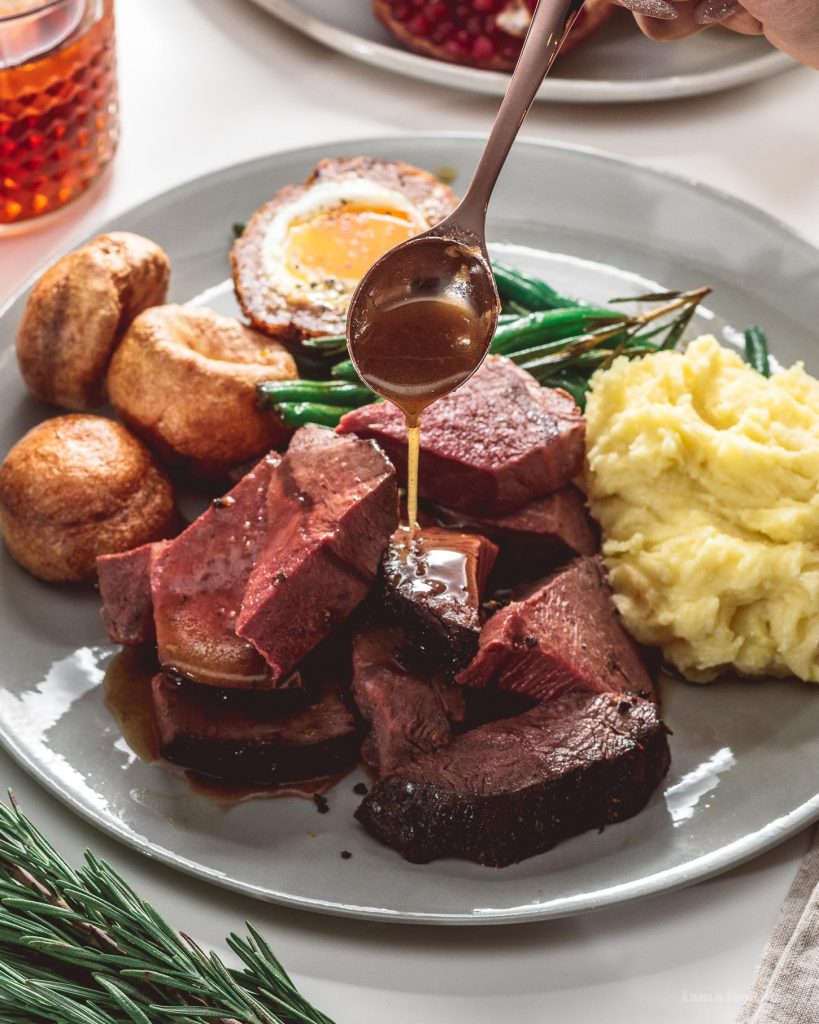From a long, slow cook to the power of a brine, here are six ways to get the job done. Pound it out. Pounding softens and tenderizes meat, making it easier to cut and eat. Harness the power of salt. Use an acidic marinade. Consider the kiwi. Give it some knife work. Slow cook it.
Is an English roast the same as a chuck roast?
Butchers might use the term English roast to refer to the beef chuck cross rib pot roast cut and boneless version of the same cut. Comparing cross rib roast versus chuck roast, the cross rib roast, or English roast, is often the more tender cut despite its tough and fatty meat from the cow’s shoulder.
How do you tenderize an English roast?
Pound it out. Pounding softens and tenderizes meat, making it easier to cut and eat. Harness the power of salt. Use an acidic marinade. Consider the kiwi. Give it some knife work. Slow cook it.
Do you cover a beef roast in the oven?
Place the meat, fat side up, on a rack in a shallow roasting pan. Roasts with a bone, such as a rib roast, don’t need a rack. Do not add water or liquid and do not cover the roast. Covering the roast would result in more steaming than roasting in the oven so we cook a beef roast uncovered.
How do I cook a beef roast without drying it out?
Here’s what I do: I put a rack in the bottom of a roasting pan. Then I place the roast (no rubs or seasonings) on the rack and cover it with a lid. I put it in the oven at 400° for 15 or 20 minutes, then turn it down to 325° and roast for 30 minutes per pound. All it does is end up tough, chewy, and well-done.
How do you make beef soft and tender?
Physically tenderize the meat. Use a marinade. Don’t forget the salt. Let it come up to room temperature. Cook it low-and-slow. Hit the right internal temperature. Rest your meat. Slice against the grain.
Should you salt a roast before cooking?
Not only do you need to season the meat aggressively, you need to do so the night before you plan on cooking it. Explains Rick Martinez, associate food editor: “You’re essentially doing a quick dry brine with salt and pepper.” This will give the seasoning ample time to permeate beyond the roast’s interior.
Why does my roast beef turn out tough?
Beef has a lot of collagen in it, and that’s what makes it tuff. If you cook it fast, the collagen contracts, and squeezes out some of the moisture. On the other hand, if you cook it real slow, the collagen can disolve/melt, and it actually adds to the mouth feel.
How do you make a roast less tough?
You may be able to salvage a roast that’s dry by adding more liquid. However, for meat that’s tough, we like to repurpose it instead. Let the meat cool, then use forks or your fingers to pull the overcooked meat into shreds. Then, use the meat to create new dishes.
What temperature should a beef roast be cooked to?
The USDA recommends steaks and roasts be cooked to 145°F (medium) and then rested for at least 3 minutes. To ensure food safety, ground beef should be cooked to a minimum 160°F (well done). Be sure to check with a thermometer, as color alone is not a foolproof indicator.
What should I Season beef with?
Basil. We love basil on almost everything. Bay Leaves. Bay leaves are wonderful for adding flavor to a large roast. Black Pepper. You can never go wrong with plain old salt and black pepper. Cayenne Pepper. Chili Powder. Cilantro. Cumin & Curry Powder. Garlic.
Why do chefs sprinkle salt from high up?
The reason why chefs season from a height is because doing so gives an even distribution of the seasoning. You see, when you sprinkle the seasoning from high up, the area where that seasoning will eventually land is much larger and therefore, the seasoning itself will be more evenly spread out.

I’m Brian Danny Max, a chef and a writer at cookingtom.com. I’m here to talk about food and cooking, and to share some of my favorite recipes with you all! I’ve been interested in food and cooking since I was a child. My parents are both great cooks, and they taught me a lot about the kitchen. I’ve been cooking professionally for about 10 years now, and I’ve loved every minute of it! I specialize in healthy, flavorful recipes that are easy to make at home. I believe that anyone can cook a delicious meal, no matter their skill level. I’m here to help you learn how to cook, and to show you that it’s not as difficult as you might think! I hope you’ll check out my blog and my recipes, and I look forward to hearing from you!

